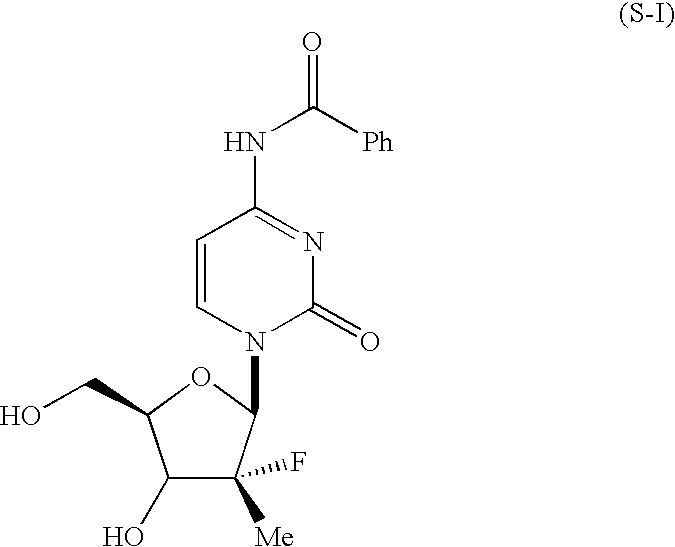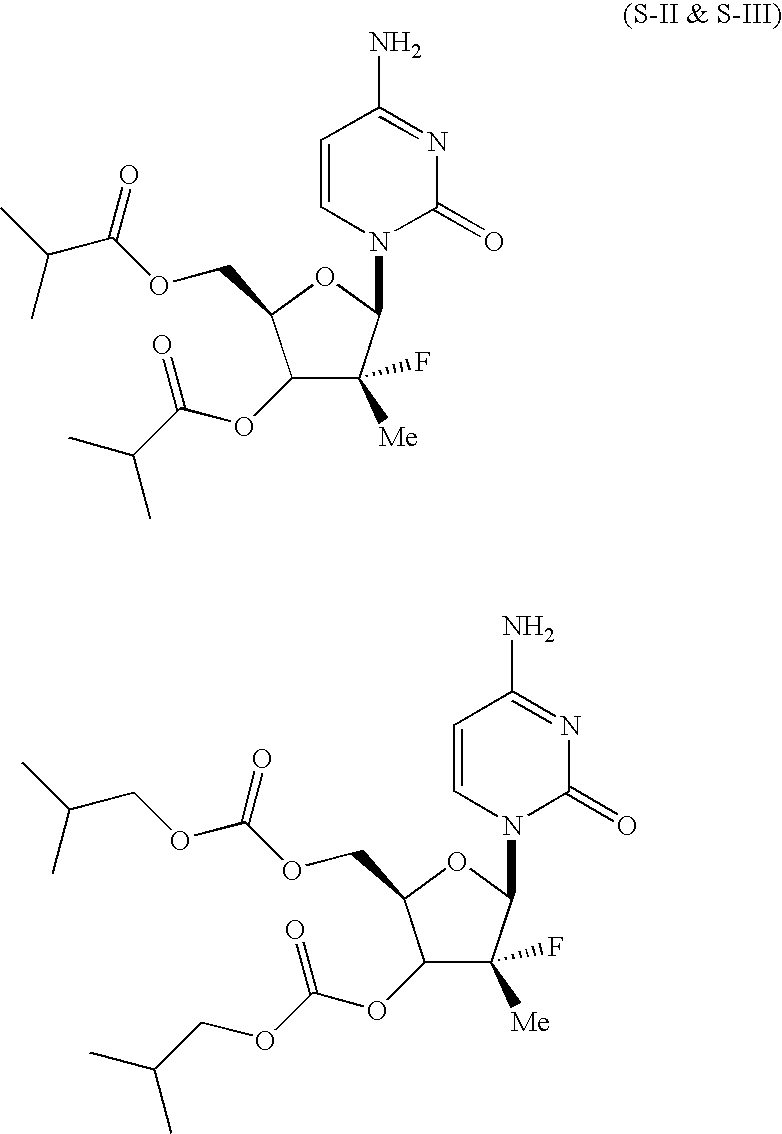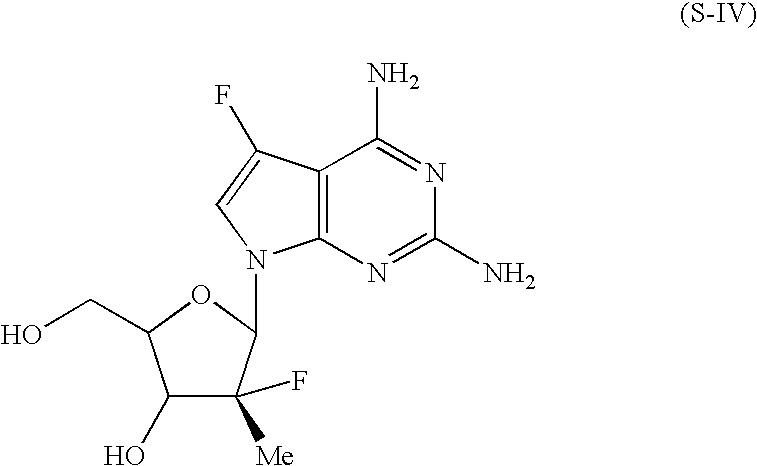Nucleoside derivatives
a technology of nucleoside analogs and derivatives, applied in the field of new nucleoside analogs, can solve the problems of viral strains whose enzymes poorly promote the phosphorylation of nucleoside analogs
- Summary
- Abstract
- Description
- Claims
- Application Information
AI Technical Summary
Benefits of technology
Problems solved by technology
Method used
Image
Examples
example 1
Preparation of ((2R,3S,4R)-3-benzoyloxy-5-(6-chloro-9H-purin-9-yl)-4-fluoro-3,4-dimethyl-tetrahydrofuran-2-yl)methyl benzoate
[0461]
[0462]To a stirred solution of 6-chloropurine (about 0.26 g, 1.74 mmol) in Acetonitrile (about 8 ml) was added 1,8-Diazabicyclo[5.4.0]undec-7-ene (about 0.52 ml, 3.48 mmol) and Trimethylsilyl trifluoromethanesulfonate (about 0.84 ml, 4.65 mmol) at about 0° C., stirred for about 15 minutes then ((2R,3S,4R)-3,5-diacetoxy-4-fluoro-3,4-dimethyl-tetrahydrofuran-2-yl)methyl benzoate (about 0.5 g, 1.16 mmol) in Acetonitrile (about 7 ml) was added and reaction continued stirring at about 65° C. for about 8 hours. Completion of reaction monitored by thin-layer chromatography and quenched with saturated sodium bicarbonate. Aqueous layer was extracted with ethyl acetate and the combined organic layers were washed with sodium bicarbonate solution, brine and dried over sodium sulphate. Concentration under reduced pressure and purification by silica gel column chromat...
example 2
Preparation of (2R,3S,4R)-5-(6-amino-9H-purin-9-yl)-4-fluoro-tetrahydro-2-(hydroxymethyl)-3,4-dimethylfuran-3-ol (Compound 2A) &
(2R,3S,4R)-4-fluoro-2-(hydroxymethyl)-5-(6-methoxy-9H-purin-9-yl)-3,4-dimethyltetrahydrofuran-3-ol (Compound 2B)
[0465]
[0466]The solutions of isomers obtained in Example 1 [((2R,3S,4R)-3-benzoyloxy-5-(6-chloro-9H-purin-9-yl)-4-fluoro-3,4-dimethyl-tetrahydrofuran-2-yl)methyl benzoate (about 0.125 g, 0.02 mmol)] were independently in methanolic ammonia (25% w / w 4 ml) was stirred at room temperature for overnight. Completion of the reaction monitored by thin-layer chromatography, methanol was removed under reduced pressure. Water added to the crude and extracted with ethyl acetate, and the organic layer was dried over sodium sulphate and concentrated under reduced pressure. Purified by silica gel column chromatography using 25% ethyl acetate: hexane to elude title compound A (Isomer I and II) and 1% methanol in dichloromethane to elude title compound B (Isomer ...
example 3
Preparation of ((2R,3S,4R)-3-acetoxy-5-(6-chloro-9H-purin-9-yl)-4-fluoro-3,4-dimethyl-tetrahydrofuran-2-yl)methyl benzoate
[0471]
[0472]To a stirred solution of 6-chloropurine (about 0.87 g, 5.7 mmol) in acetonitrile (about 20 ml) was added 1,8-Diazabicyclo[5.4.0]undec-7-ene (about 1.7 ml, 11.4 mmol) and Trimethylsilyl trifluoromethanesulfonate (about 2.76 ml, 15.2 mmol) at about 0° C., stirred for about 15 minutes then ((2R,3S,4R)-3,5-diacetoxy-4-fluoro-3,4-dimethyl-tetrahydrofuran-2-yl)methyl benzoate (about 1.4 g, 3.8 mmol) dissolved in Acetonitrile (about 20 ml) was added and reaction continued stirring at about 65° C. for about 8 hours. Completion of reaction monitored by thin-layer chromatography and quenched with saturated sodium bicarbonate. Aqueous layer was extracted with ethyl acetate and the combined organic layers were washed with saturated sodium bicarbonate solution, brine and dried over sodium sulphate. Concentration under reduced pressure and purification by silica ge...
PUM
| Property | Measurement | Unit |
|---|---|---|
| temperature | aaaaa | aaaaa |
| temperature | aaaaa | aaaaa |
| temperature | aaaaa | aaaaa |
Abstract
Description
Claims
Application Information
 Login to View More
Login to View More - R&D
- Intellectual Property
- Life Sciences
- Materials
- Tech Scout
- Unparalleled Data Quality
- Higher Quality Content
- 60% Fewer Hallucinations
Browse by: Latest US Patents, China's latest patents, Technical Efficacy Thesaurus, Application Domain, Technology Topic, Popular Technical Reports.
© 2025 PatSnap. All rights reserved.Legal|Privacy policy|Modern Slavery Act Transparency Statement|Sitemap|About US| Contact US: help@patsnap.com



